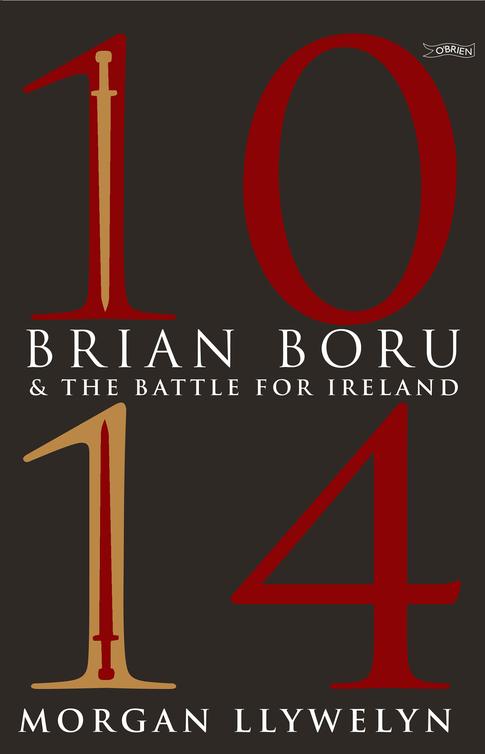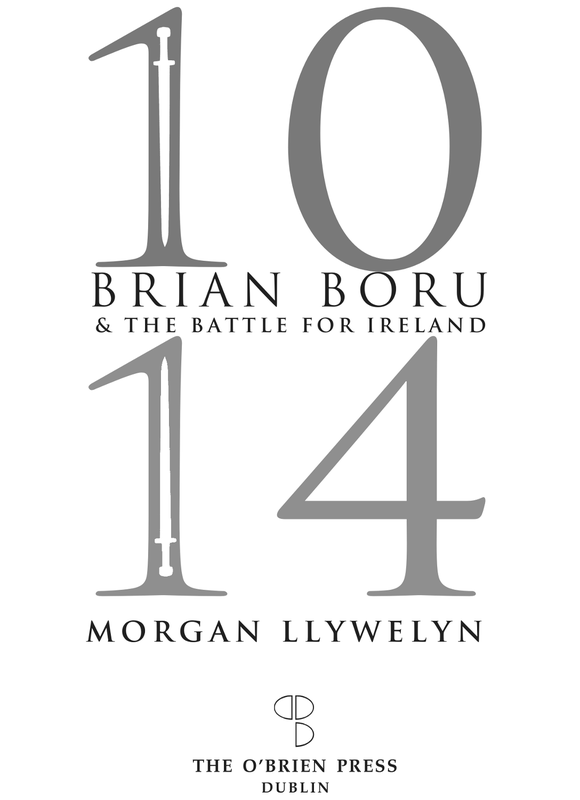1014: Brian Boru & the Battle for Ireland
Read 1014: Brian Boru & the Battle for Ireland Online
Authors: Morgan Llywelyn



Dedication:
For Patricia MacMahon and, as always, for Charlie
ONTENTS

- Title Page
- Dedication
- A
UTHOR’S
N
OTE - F
OREWORD
T
HE
R
T
. H
ON
. C
ONOR
O’B
RIEN - I
NTRODUCTION - Maps
- P
ROLOGUE
: M
ORNING - C
HAPTER
1
I
RELAND - C
HAPTER
2
I
RELAND IN THE
T
ENTH
C
ENTURY - C
HAPTER
3
V
IKINGS - C
HAPTER
4
T
HE
P
RINCIPALS - C
HAPTER
5
A S
PARK IN
D
RY
T
INDER - C
HAPTER
6
T
HE
N
ORTHERN
C
ONSPIRACY - C
HAPTER
7
C
ALL TO
A
RMS - C
HAPTER
8
T
HE
D
RAGONS
A
RE
C
OMING - C
HAPTER
9
T
HE
W
EEK
B
EFORE - C
HAPTER
10
T
HE
B
ATTLEGROUND - C
HAPTER
11
B
ATTLE
M
ORNING:
S
UNRISE
, 23 A
PRIL
1014 - C
HAPTER
12
A
TTACK
! - C
HAPTER
13
T
HE
E
ND OF THE
D
AY - C
HAPTER
14
S
UNSET - C
HAPTER
15
A
FTERWORD - K
INCORA - S
ELECT
B
IBLIOGRAPHY - About the Author
- Copyright
Most of the Irish names in this book are given a
pronounceable
English equivalent. For example, Briain Bórumha becomes Brian Boru; Maelseachlainn Mór becomes Malachy Mór, and Dubhchobhlaigh is rendered as Duvcholly. Gormlaith (Gormfhlaith in Irish) is an exception, due to her notoriety. Her name is pronounced Gurmla, but she is far better known as Gormlaith.
Placenames
also are given in English. Dates conform to the Christian calendar as it was used in Ireland in 1014 of the Current Era.
M
organ Llywelyn, one of the world’s most
successful
and respected historical novelists
writing
about Ireland and the Celtic culture, has departed from fiction to present a factual history of one of Ireland’s milestone events.
1014: The Battle of Clontarf, is one of the first dates that an Irish child learns in school. 1014 is as significant for Ireland as 1066 and the Battle of Hastings were for the English. In this groundbreaking book published in 2014, its millennium year, Llywelyn employs her unique skills to bring the Battle of Clontarf to life once more. She offers not just a recitation of the names and dates but a vivid glimpse into the past in all its dramatic and bloody
reality. She has an uncanny knack of carrying the reader back through time and a deep, almost intuitive
understanding
of ancient Ireland.
Llywelyn’s approach to the Battle of Clontarf takes a fresh look at the generally accepted accounts which have been written and re-written over the centuries. Scholars and historians continue to argue over who was there and what happened that day. Llywelyn is not afraid to widen the posts of historical interpretation and possibilities. Nor is she reluctant to seek out the answers others have overlooked. The result is an historical account to stand with Cecil Woodham-Smith’s
The Reason Why
about the Charge of the Light Brigade.
The author’s intensive study of Brian Boru began with research for her international bestseller
Lion of Ireland
, and has continued ever since, focusing on the character of Ireland’s greatest high king as demonstrated through his actions. Drawing upon her unique understanding of Brian, now Llywelyn has produced an authentic portrait of the man who worked so hard to assure Ireland of lasting peace and prosperity – until the triumph and tragedy of 1014.
As a direct descendant of Brian Boru and Chief of the Name, I believe we O’Briens are lucky indeed to have Morgan Llywelyn as our modern day bard.
The Rt. Hon. Conor O’Brien, the Lord Inchiquin
B
rian Boru is a prominent figure in the histories of early medieval Ireland, yet when my historical novel,
Lion of Ireland
, was first published in 1980 there was no other book in print about Ireland’s most famous high king. No biography of him existed. Some of the people with whom I discussed the project in the
beginning
assured me that Brian was a fictional hero from Celtic folklore, like Cúchulainn or Fionn mac Cumhaill. There could have been no such person because Irish
historical
heroes were always failures. Everyone knew that, they said. And even if someone of that name had existed, nothing was known about him. They said.
They were wrong on both counts. Brian Boru was a real person. Determined research uncovered enough information to construct a novel around him, though I did not stop there.
SOURCES
The known facts about Brian are contained within
several
Irish annals compiled contemporaneously with or
shortly after his life, as well as a few Norse texts. All of the subsequent accounts over the centuries have been taken from this material and reworked according to the
opinions
and prejudices of the writers and historians involved. These have provided an endless source of controversy and will continue to do so into the far future.
Since
Lion of Ireland
became an international bestseller, numerous writers and scholars as well as film makers have rediscovered Brian and wanted to retell his story. All face the same problem I did: when it comes to documentation there are only the archaic records to draw upon, and those can be contradictory and confusing. Beyond them everything is and must be speculation, conjecture, and educated guesswork.
My continuing interest in the character and career of Brian Boru has resulted in the collection of a sizeable library devoted to him and the world he inhabited (see the partial bibliography at the end of the book). In 1983 Roger Chatterton Newman published the first
nonfiction
biography of Brian,
Brian Boru, King of Ireland
. And 1990 saw the publication of my book for young readers entitled
Brian Boru, Emperor of the Irish
, which won the Bisto Award for Excellence. As we approach the thousandth anniversary of Brian’s greatest battle, it seems appropriate to revisit Clontarf and make an effort to
understand what really happened on Good Friday, 1014. The foreign invaders combined with the rebel Irish had superior numbers and weaponry, yet Brian Boru won. The great question is – how?
Writing an accessible non-fiction history of the Battle of Clontarf was a challenge. In 1986-87 I had published
Xerxes
, a biography of the Persian warrior-king
commissioned
by City College of New York, and was familiar with the task of reconstructing ancient battles. To set the events of 1014 in context required a condensed outline of the socio-political situation of Ireland in the late ninth century and a re-examination of the known facts.
But more was necessary to open up this story to a wider audience. Both historians and biographers employ speculation to address gaps left in the fabric of the distant past. As a historian I have great respect for the facts; as a novelist I appreciate the drama and sense of immediacy that fiction can produce. No fact or incident has been invented in this book, but if their history is to be more than dry bones the people involved needed to be given flesh and blood, and have some of the small details of their everyday lives brought to light. The techniques of a novelist have been employed to set scene and
atmosphere
. The best-known legends surrounding Brian and the battle have been included because they are such an
integral part of the whole. Still, there is so much we cannot really know, including the motives and emotions of the men and women who lived a thousand years ago. These are the elements which allow the greatest latitude for conjecture; humans are always the most intriguing.
Three things are certain: Brian Boru actually lived. A great battle took place in 1014. And Ireland won.
* * *
I wish to thank Éamonn de Burca of de Burca’s Rare Books for helping me on the initial, sometimes
frustrating
search for material about Brian Boru’s Ireland. Without Éamonn’s guidance I would never have located some of the more obscure works now in my personal collection. The late Cornelius Howard of the
Department
of Foreign Affairs introduced me to the owners of private libraries, here and abroad, who let me study rare manuscripts that were not available to the public. Professor George Meier, then head of the Department of Celtic Studies in Georgetown University, Washington, D.C. gave me access to important material which had long since left Ireland. The Rt. Hon. Conor O’Brien, the Lord Inchiquin, who is thirty-second in the line of descent from Brian Boru, graciously provided me with family details not available anywhere else.
Public libraries in both Dublin and County Clare have
been of help with this project, as have numerous
conversations
with military experts. The National Library of Ireland has been the principal source for maps relating to pre-Norman Ireland, while thanks go to the Dublin Civic Museum for providing topographical details, and to the Irish Meteorological Office for their tidal calculations.
Dublin and its environs have changed drastically since 1014. The blood-soaked battlefield where so many fought and died lies under tonnes of earth, obliterated by a thousand years of haphazard construction. In 1979 the extensive remains of Viking Dublin – the largest such settlement outside of Scandinavia, and a treasure trove of irreplaceable archaeology – were bulldozed and buried beneath new civic offices by Dublin Corporation.
A person visiting Clontarf today expecting to see the battlefield would be in for a shock. The topography of north Dublin has been totally reshaped. Therefore
special
thanks are due to the late historian Éamonn Mac Thomáis and to the intrepid Frank Cullen. Three
decades
apart, these two men generously accompanied me on foot-by-foot explorations of the area which was once a battleground, as proved by the many artefacts found there. The purpose was to correlate distances, elevations and viewing points with the annalists’ descriptions of the events.
In 1988 broadcaster Donncha Ó Dulaing invited me to join in walking from Clare to Clontarf. Our party of dedicated walkers spent fourteen strenuous days
following
in the footsteps of Brian Boru on his way to the great battle, although our purpose was to raise money for charity rather than to fight invaders. No research book could equal the actual physical experience of the march, and I can never thank Donncha enough. Sincere thanks also to the scholars, historians and military enthusiasts, too numerous to name, who contributed in other ways to the compilation of this book. Each of you provided a piece of the puzzle. Any errors within these pages are entirely my own.
Lastly, but by no means least, I wish to thank Michael O’Brien and his talented team at The O’Brien Press for giving me this opportunity to revisit Brian and his
Ireland
one more time.
Morgan Llywelyn, Dublin, 2013
